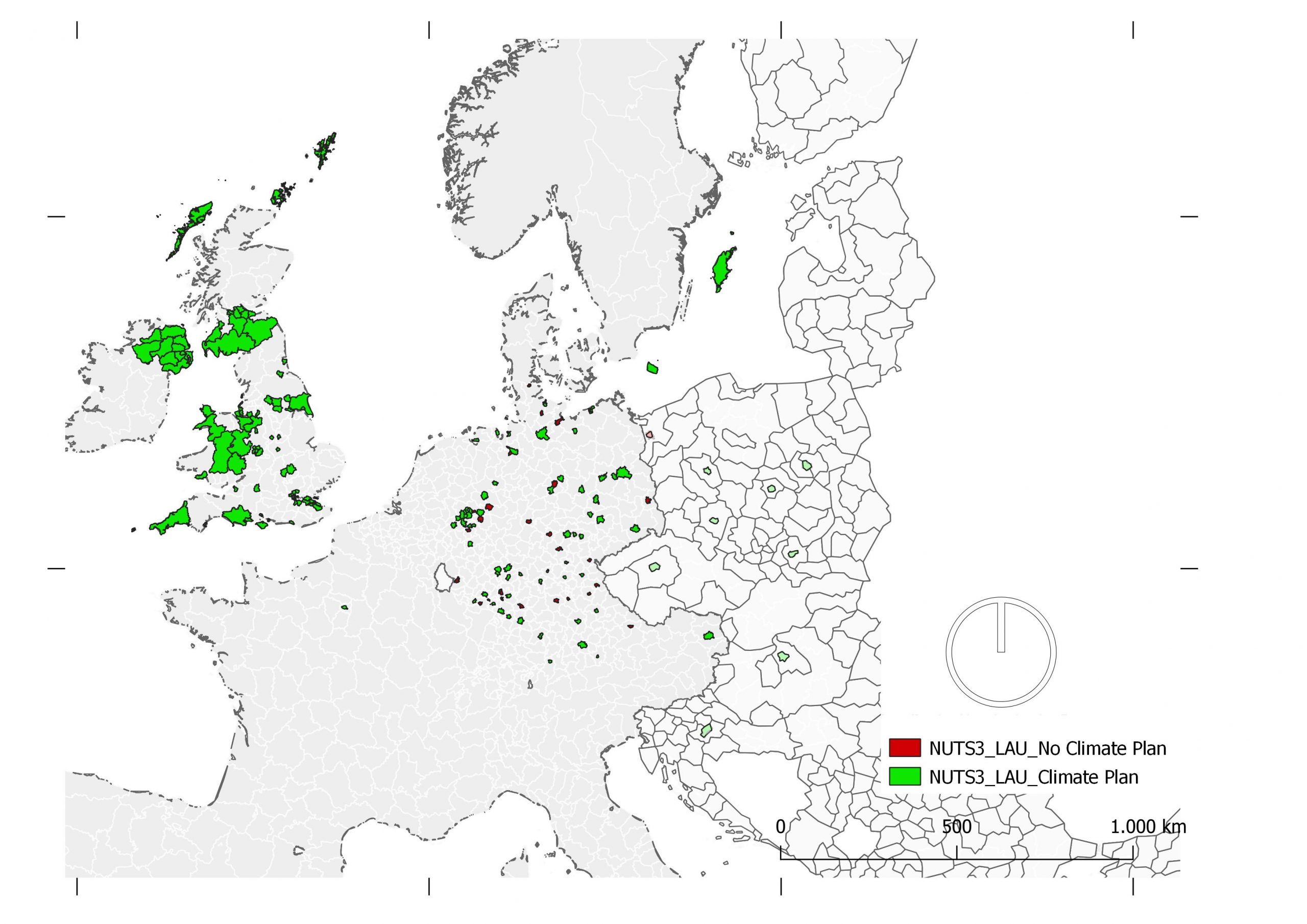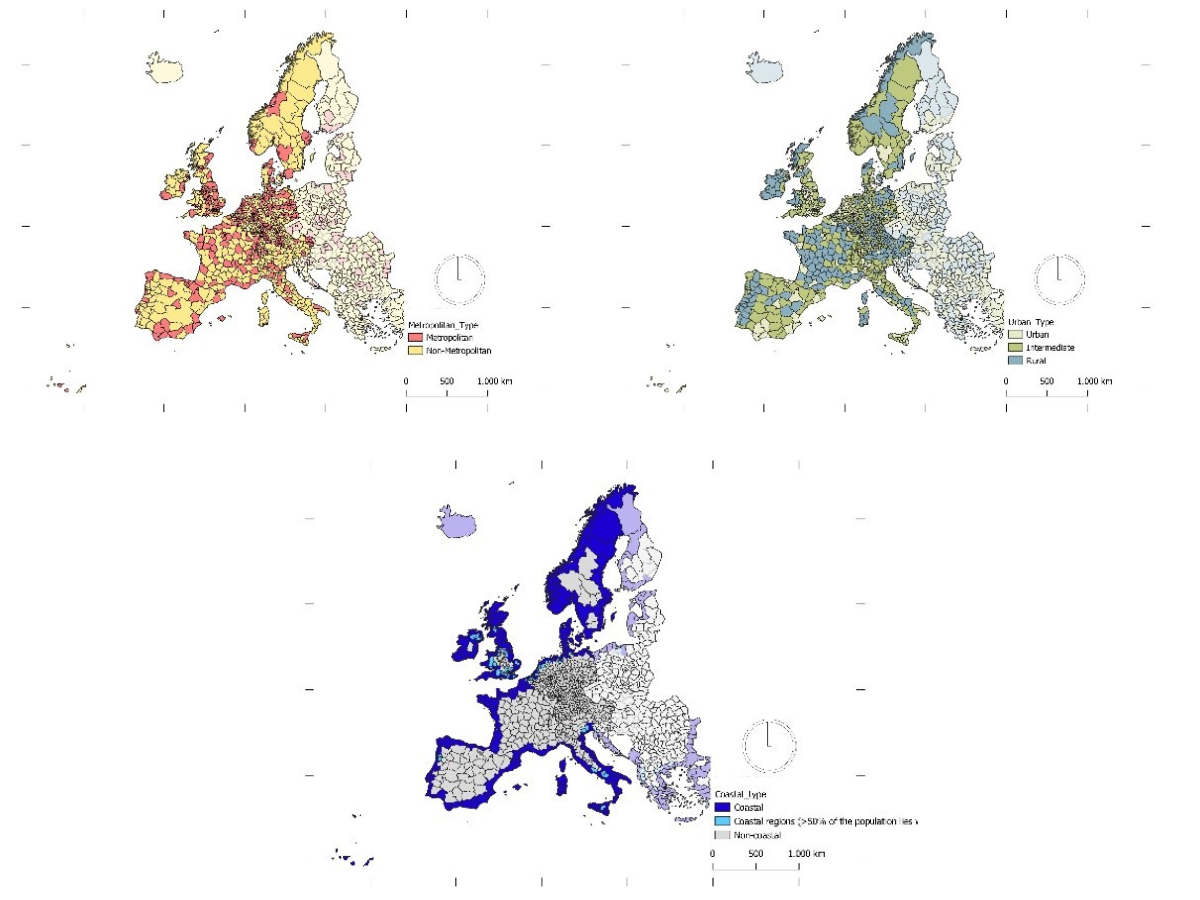
Map of the European NUTS3 regions coincident with Local Administration Units with Climate Plan (Green) and No Climate Plan (Red). Source: Martínez Görbig (2022), based on data from Eurostat, Covenant of Mayors, Carbon Disclosure Project, and websites from the regional administrations.
In assessing feasible mitigation and adaptation measures in a particular region, immediate-context conditions should be considered (Williams et al., 2021; Rempel et al., 2022; Busch et al., 2022; Jewell and Cherp, 2020; IPCC, 2022). However, existing studies are conducted globally to assess feasible mitigation or adaptation measures. This contradiction leads to high uncertainty when selecting the most appropriate measures for a region to reach its decarbonisation goal. This dichotomy is one of the reasons for the existing gap in the implementation of adaptation and mitigation pathways. According to the data from the Carbon Disclosure Project (CDP) database – an initiative where cities and regions report the state of their climate actions – just around 30% of all planned climate actions in Europe have already been implemented. The same patterns are followed when looking at the implementation status of European mitigation and adaptation plans reported in that database (CDP).
Moreover, climate change impacts do not understand administrative borders, and cross-border considerations are needed to appropriate climate planning (Carter et al., 2021; Benzie and Persson, 2019). In the CDP database, about 20% of the localities admitted the need to rescale their plan to a broader scale. Therefore, covering a regional scale rather than localities could help improve climate planning since it covers a larger area and allows one to focus on the immediate context. LOCALISED is covering EU-28 by using NUTS3 regions as the target scale.

Tercet’s three NUTS3 regions typologies. Source: Martínez Görbig, 2022, based on data coming from European Commission – Eurostat/GISCO (2021).
NUTS3 regions are the smallest statistical unit in Europe, according to the Eurostat-EC (2021), with 1.166 of them. Those regions are categorised into Tercet. Tercet is a regulation initiative that aims to integrate typologies into regulation and policy planning in the EU28, based on typologies created by Eurostat, DG Regio, the Joint Research Centre, and the OECD: the urban-rural typology, the coastal typology, and the metropolitan typology. However, Tercet is not yet visible in climate planning. Previous research on monitoring climate plans shows a considerable climate response at the local scale but not at the regional scale. Just 3.36% of the mitigation plans and 5.51% of the adaptation plans reported to the CDP database come from a regional perspective. Moreover, after checking for local governments with regional decision-making capacity with a public and available climate plan, it has been found that just 154 out of the 1.166 NUTS3 regions are covered.
As LOCALISED will use NUTS3 regions as territorial units, relevant contributions are expected to improve climate planning at an appropriate scale.
Authors: University of Twente, Gerard Martínez Görbig, dr. Diana Reckien, dr. Johannes Flacke.
References:
Benzie, M., Persson, Å. Governing borderless climate risks: moving beyond the territorial framing of adaptation. Int Environ Agreements 19, 369–393 (2019). https://doi.org/10.1007/s10784-019-09441-y
Busch, P., Kendall, A., Murphy, C. W., & Miller, S. A. (2022). Literature review on policies to mitigate GHG emissions for cement and concrete. Resources, Conservation and Recycling, 182 (November 2021), 106278. https://doi.org/10.1016/j.resconrec.2022.106278
Carter, T. R., Benzie, M., Campiglio, E., Carlsen, H., Fronzek, S., Hildén, M., Reyer, C. P. O., & West, C. (2021). A conceptual framework for cross-border impacts of climate change. Global Environmental Change, 69, 102307. https://doi.org/10.1016/j.gloenvcha.2021.102307
Jewell, J., & Cherp, A. (2020). On the political feasibility of climate change mitigation pathways: Is it too late to keep warming below 1.5°C? WIREs Climate Change, 11(1). https://doi.org/10.1002/wcc.621
IPCC, 2022: Climate Change 2022: Impacts, Adaptation, and Vulnerability. Contribution of Working Group II to the Sixth Assessment Report of the Intergovernmental Panel on Climate Change [H.-O. Pörtner, D.C. Roberts, M. Tignor, E.S. Poloczanska, K. Mintenbeck, A. Alegría, M. Craig, S. Langsdorf, S. Löschke, V. Möller, A. Okem, B. Rama (eds.)]. Cambridge University Press. In Press
Rempel, A., & Gupta, J. (2022). Equitable, effective, and feasible approaches for a prospective fossil fuel transition. WIREs Climate Change, 13(2). https://doi.org/10.1002/wcc.756
Williams, P. A., Simpson, N. P., Totin, E., North, M. A., & Trisos, C. H. (2021). Feasibility assessment of climate change adaptation options across Africa: an evidence-based review. Environmental Research Letters, 16(7), 073004. https://doi.org/10.1088/1748-9326/ac092d

Recent Comments